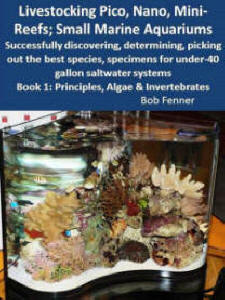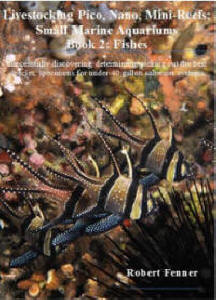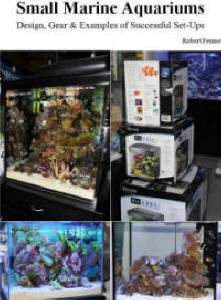|
Related FAQs: Small System Stocking, Small Marine System Livestocking 2,
Small Marine Stocking 4, Small Marine Stocking 5, Small Marine Stocking 6, Small Marine Stocking 7, Small Marine Stocking 8, Small Marine Stocking 9, Small Marine Stocking 10, Small Marine Stocking 11, Small Marine Stocking 12, Cnidarians for Small
Volumes,
Related Articles:
Cnidarians for
Small Systems by Bob Fenner, Small Scorpionfishes: Lionfishes and More for
Small Systems by Bob Fenner, Blennies, -oids for Small Systems by Bob
Fenner, Damsels, Clownfishes for Small
Systems by Bob Fenner, Dwarf Dwarf
Angels of the Genus Centropyge by Bob Fenner, Jawfishes Suitable for Small Marine
Systems by Bob Fenner, Little
Basses for Small Systems by Bob Fenner, Nano Reef Systems by Adam
Jackson, It's a Small World, Pico Tanks, By
Kirby Adams, Tom
Walsh's Small Reefs, Moving
Aquariums, Marine
Planning, Getting Started with a Marine Tank By
Adam Blundell, MS, Marine Biotope, Marine Landscaping, Fishwatcher's
Guides,
Putting Together
Livestock Assortments for Small Systems
|

|
|
By Bob Fenner
|
An ebook on the subject
by RMF |
 |
 |
 |
Small Marine Aquariums
Book 1:
Invertebrates, Algae
New
Print and
eBook on Amazon:
by Robert (Bob) Fenner |
Small Marine Aquariums
Book 2:
Fishes
New
Print and
eBook on Amazon: by Robert (Bob) Fenner |
Small Marine Aquariums
Book 3:
Systems
New
Print and
eBook on Amazon:
by Robert (Bob) Fenner |
Without doubt the
single largest stumbling block for small volume marine aquariums is poor
organization, lack of study in gathering appropriate livestock. The vast
majority of systems fail as consequences of ultimately too large, too
aggressive, too stinging, too toxic, overall just incompatible mixing of
life that can neither fit in such dimensions, and/or can’t get along
with each other. Here I will do my level best to share with you the
major points of what species to sort through (amongst those you’re more
likely to find available), and secondly, though just as importantly, how
to select for the most fit specimens.
Species Selection Criteria:
“Life is a series of compromises”. This is a profound
understanding, indeed, a “hurdle” of maturity if you will in the
development of one’s growth in the real world. This view of the universe
certainly applies to “guessing at” what is likely to be good/better/best
in the way of biota to place in your tank. Assuredly you won’t be able
to have everything you’d like to in any given sized system… unless it
was oceanic in proportions. You will have to make choices between what
is more/less likely to go together. Know also that even given the most
bonafide “reef safe” species, there will be individuals that fall
outside a/the “norm” for easygoing- or hardy-ness. What to do with this
reality? Keep it in mind and keep moving forward.
Size matters… Either the life you choose should stay small,
and/or be of low metabolic and behavioral activity. Larger organisms
just won’t fit; or alternatively, should “something” go awry (power
outage, overfeeding incident…) your margin of safety may be too small to
react in time to save the system’s life forms. Though a juvenile
specimen of a shark or eel may physically fit in your small system, they
will grow to be too large, and when (not if) gear or the power itself
fail, these animals will perish in short order.
|
The
Snowflake, Starry, or Diamond-Backed
Moray, Echidna nebulosa (Ahl
1789) is a fabulous aquarium species;
small, compatible with other fish
species and adaptable to captivity. It
is certainly the most peaceful, outgoing
and desirable moray species. To about
thirty inches total length. Base color
of silver gray with black and yellow
"snowflakes" randomly sprinkled over the
lower body. No morays commonly available
in the trade fit in less than 40 gallons
well or long.
|

|
And not just size matters: There are MANY species of fishes and
non-fish livestock that can’t simply “take” being crammed into a small
volume. Though they may be diminutive in size themselves, they’re
hard-wired behaviorally, physiologically, metabolically with a need for
room. A great example here is the many popular species of Flasher
Wrasses of the genus Paracheilinus. Though topping out at about 3 inches
in length, without a span of three or more feet to run/swim about, not
only will they not do their flash displays, but dwindle altogether.
|
Paracheilinus mccoskeri
Randall & Harmellin-Vivien 1977,
McCosker's Flasher Wrasse. Western
Indian Ocean: Comoros, Andaman Sea and
Maldives. To two and a half inches in
length. A flashing male in S. Sulawesi (Wakatobi)
|

|
Aggressiveness: Either you’ve got to assure that “A” gets along
with “B” and all other letters down the line, or settle on just having
“A” all by itself if it’s just too agonistic, or it in turn is too
likely to get picked on. Sterling examples here are the smaller species
of Angler- or Frog-fishes, family Antennariidae. Smaller species,
specimens of Anglers can be picked out that will be unable to inhale
their tankmates, as long as those other organisms will in turn leave the
Frogfish alone.
|
Antennarius maculatus
(Desjardin's 1840), the Clown
Anglerfish. Indo-Pacific. To four inches
in length. Often seen out in the open,
especially when small, apparently
mimicking toxic Nudibranchs. Most are
white with orange or red mottling, but
many colors exist. Have prominent
illicia ("fishing poles") that resemble
small fishes. N. Sulawesi pix.
|

|
Feeding Compatibility:
should be kept in mind when considering a mix of species; will all be
able to get food easily? Or will some organism require too much
specialized catering to suit you and it? The Mandarins labeled
“Psychedelic Gobies” are good examples of such species… needing a good
deal of live food on a continuous basis; but unable to compete with more
fast moving, more active feeders if placed together.
Chemical & Physical Compatibility; Toxic Life: There are likely
more cases of life in the shallow seas having such “communication” than
not. Particularly where reef life is sedentary; slow to move or stuck in
place (versus fishes being able to swim away) organisms have various
mechanisms to “keep their turf”. Some of these interactions are of more
than academic interest to us as aquarists; mis-mixes warring with each
other to extents of poisoning others to causing collapse of the entire
system. Most-celebratedly, the animals collectively called “corals” by
most hobbyists can/do sting, poison, attempt to eat each other
competitively. However the Cnidarians don’t have a monopoly on such
subterfuge. Most all colorful, slow-no-moving sealife; algae,
Nudibranchs, several Sea Cucumbers and much more has something that
prevents its displacement or consumption. Here are but a few examples:
|
Caulerpa...
this genus can be toxic if grown too
much, too fast, in the absence of decent
filtration and maintenance. Its species
are not to be trusted in small volumes.
|

|
|
Tube Anemones
are bad “shedders” of stinging material,
and should be kept with only commensals.
Within the pet-fish trade worldwide the
most common species offered is
Cerianthus membranaceus from the
Philippines, but all are too toxic to
mix in a community setting.
|

|
|
|
|
|
Phyllodesmium hyalinum
Ehrenburg 1831. Indo-West Pacific; Red
Sea to Malaysia. N. Sulawesi. This
“Solar Powered” Nudibranch can take out
a small system if it dies and dissolves
without detection.
|

|
|
"Australian"
Sea Apple, Paracucumaria tricolor
(sometimes labeled as
Pseudocolochirus violaceus (Theel
1886); called as such though it is
generally imported from the Philippines
and Indonesia... It's a killer that I've
seen take entire systems with it
eviscerating, otherwise falling apart.
|

|
Some of this life either has to be kept by
itself, i.e. in “species only displays”, but a good deal of it can be
acclimated to each other’s presence within reasonable risk. This
is where your separate isolation/quarantine system really comes in
handy. Not only giving new acquisitions needed time to rest up from the
travails of capture, shipping, but allowing you to mix water back and
forth, slowly introducing would-be competitors to each other.
Numbers, Sexes of Individuals:
Schooling, shoaling species and ones that live in haremic situations
abound in both fish and invertebrate groups. Again, the onus is upon you
to investigate the life habits of the livestock you’re interested in. My
fave “poster animals” include some of the popular Cleaner Shrimp (not
all species!), Cardinalfishes (again, not all species!), and to re-use
them, the Flasher Wrasses (genus Paracheilinus), whom w/o female
presence will grant you nary a flash.
|
Rhynchocinetes durbanensis
Gordon 1936, the Durban Dancing
Shrimp. Indo-West Pacific; Red Sea to
the Philippines. Need reef tank
conditions, but not with much light,
lots of hiding spaces. In the wild live
in large associations (dozens to
hundreds of individuals) within rocky
caves, areas N. Sulawesi pix.
|

|
|
Apogon
leptacanthus Bleeker
1856-57, Threadfin Cardinalfish.
Indo-Pacific including the Red Sea. To a
little over two inches in length. Found
in dense school in the wild. This group
in a friend’s aquarium.
|

|
Being an old-timer (oh to be young and foolish instead of middle-aged
and foolish), my approach to putting together a working livestock
assortment is analog: I make hand-written (and computerized!) lists of
what I’m interested in and hit the stacks at the library, the Net, and
ask folks I know and trust at LFS’s and fish clubs.
Beyond the “What” Species to Which
Specimens:
Once you’ve done your best theoretically to determine of what you’d like
to keep, whittled that down from what can be found locally or through
etailers, now comes an entirely separate skill set and activity… the
hunt for better to best individual specimens for you to acquire. Though
there are hundreds of pages that could be presented for you to ponder,
the bulk of what is useful can and will be related here. The most
important factors in searching are:
1)
Be patient! Don’t buy “just arrived” specimens
if you can avoid it. Most livestock dies within a day or two of being
moved, particularly the long travel from the wild through the chain of
custody so to speak, from collector, distribution, r/etailer to you. If
possible, leave new livestock a week or so at your dealers before taking
it home. Stay patient! Place new livestock in a systematic manner… the
less aggressive, noxious specimens first; ahead of the more agonistic,
toxic species.
2)
Make sure it’s feeding! An “acid test” yes/no
question in the purchase of any specimen. If it’s not eating foods that
you can get, intend to use, leave the livestock at the dealers till they
can prove it is.
3)
Pass over damaged, obviously diseased stock!
You’re not likely to be able to “cure” specimens that are already
deficient. If there are ANY dead, dying specimens in the system, I’d
give them all a pass. Know what “normal” behavior is like for the
species involved, or bring your “guru” aquarist along to teach you, and
only pick out “happy” individuals.
4)
Isolate/Quarantine (Most) New Livestock! There
are exceptions (species that suffer more for delay… stress, starvation)
from not being summarily placed, but most of the life we keep does
unarguably better historically, given time to rest up, become familiar
with captive foods, confines, and not subjected to your established
social dynamic. Besides, keeping the new stock separate is the best
assurance of avoiding introduction of pests and parasites.
 |
 |
 |
Small Marine Aquariums
Book 1:
Invertebrates, Algae
New
Print and
eBook on Amazon:
by Robert (Bob) Fenner |
Small Marine Aquariums
Book 2:
Fishes
New
Print and
eBook on Amazon: by Robert (Bob) Fenner |
Small Marine Aquariums
Book 3:
Systems
New
Print and
eBook on Amazon:
by Robert (Bob) Fenner |
|
|

